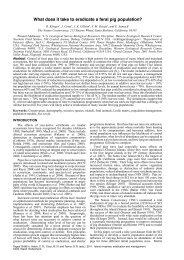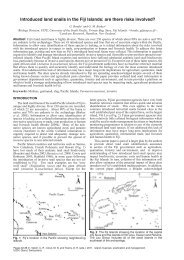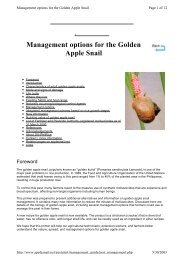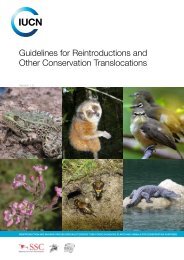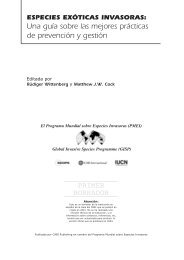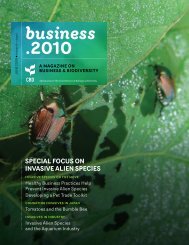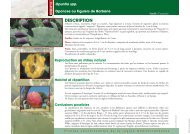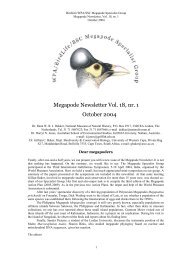Aliens Newsletter - ISSG
Aliens Newsletter - ISSG
Aliens Newsletter - ISSG
Create successful ePaper yourself
Turn your PDF publications into a flip-book with our unique Google optimized e-Paper software.
Figure 4. Beaver effects in Tierra del Fuego riverine environments: abandoned site where beech forest was replaced<br />
by a grassland meadow currently grazed by feral horses (Equus caballus). Photo: M. Fernanda Menvielle<br />
Invasions also have economic effects, and beaver invasion<br />
is not an exception. Beaver flooding is affecting<br />
road infrastructure in Patagonia, as well as<br />
ranching infrastructure (Parkes et al.2008). However,<br />
economic impacts are yet to be seen in South<br />
America given the fact that Nothofagus forests extend<br />
northward to about 34 ºS in South America (Veblen<br />
et al. 1996 in Parkes et al. 2008), meaning that<br />
beavers have the potential to expand their range<br />
about 2,000 km to the north, going deep in the South<br />
American continent. The results of beaver engineering<br />
in mainland would significantly increase economic<br />
impacts derived from its invasion, affecting<br />
forestry and agricultural industry, reducing quality<br />
of protected areas, altering the hydrology of catchment<br />
areas that are the source for water and power<br />
supply (Parkes et al. 2008). Based on the impacts<br />
that beavers have in Tierra del Fuego, we can expect<br />
that their expansion in the continent will take<br />
not only a qualitatively, but also a quantitatively different<br />
dimension, never seen before in South<br />
America.<br />
Beaver management in Patagonia<br />
Beaver management in the region has had similar<br />
characteristics in Argentina and Chile. It began thirty-five<br />
years after beaver introduction in 1981, when<br />
hunting was allowed for damage control in Argentina<br />
(Parkes et al. 2008). Between 1999 and 2001 both<br />
countries started control programs encouraging<br />
commercial use as a management tool. The assumption<br />
behind these programs was that beaver pelts had<br />
a commercial value, based on which, private and<br />
public trappers were encouraged by bounties given<br />
by governments that also assisted in developing<br />
markets, to pursue beaver capture (Parkes et al<br />
12 29/2010



